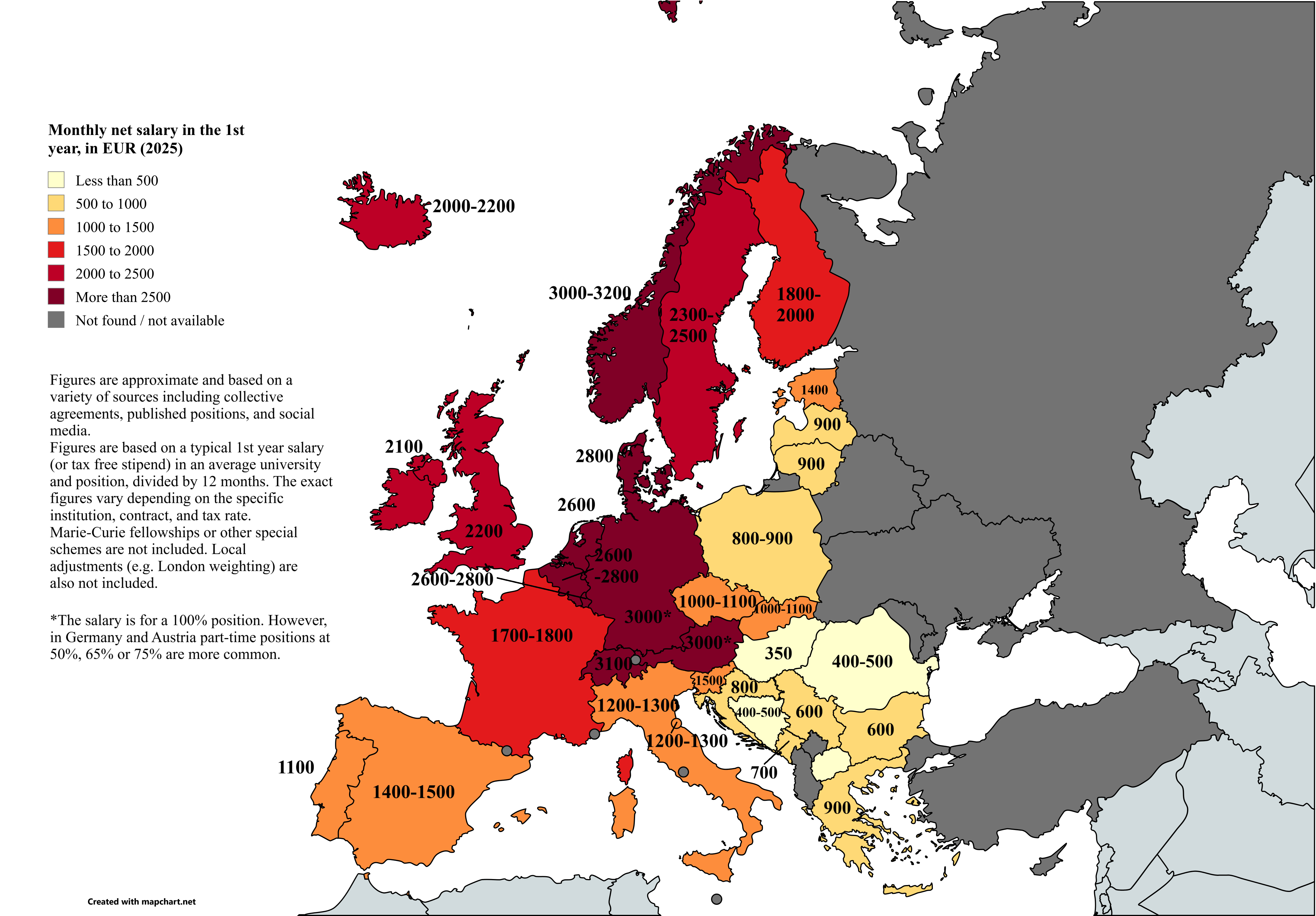PhD Students Salaries in Europe Map


Alex Cartwright
Senior Cartographer & GIS Specialist
Alex Cartwright is a renowned cartographer and geographic information systems specialist with over 15 years of experience in spatial analysis and data...
Geographic Analysis
What This Map Shows
The "PhD Students Salaries in Europe Map" provides a detailed visualization of the average salaries received by PhD students across various European countries. This map highlights not only the disparities in financial compensation but also reflects broader trends in higher education funding and labor market conditions. Understanding these salary variations is crucial for prospective PhD candidates considering where to pursue their advanced studies.
Deep Dive into PhD Salaries in Europe
PhD student salaries can vary significantly across Europe, influenced by factors such as the country’s economy, the field of study, and institutional funding. In many cases, the financial support offered to PhD candidates is closely tied to government policies and the level of investment in research and development.
Interestingly, countries with a stronger emphasis on innovation and research tend to offer higher salaries for PhD students. For instance, nations like Germany and Switzerland are known for their robust funding systems and high living standards, leading to more competitive PhD salaries. In Switzerland, for example, average salaries can reach upwards of €60,000 annually, making it an attractive option for many aspiring researchers.
On the other hand, countries with less investment in higher education may offer lower stipends, which can be a significant deterrent for potential PhD candidates. Countries in Southern Europe, such as Greece and Portugal, often report much lower average salaries, sometimes falling below €20,000 per year. This disparity can create challenges for students who may need to balance their academic commitments with part-time work to support themselves.
Moreover, the field of study plays a critical role in salary differences. STEM (Science, Technology, Engineering, and Mathematics) fields generally see higher stipends compared to humanities or social sciences. For example, engineering PhD candidates in countries like Sweden or the Netherlands might earn considerably more than their counterparts in the arts. This trend reflects not only the market demand for technical skills but also the funding priorities of various universities.
Additionally, the cost of living in certain countries must be taken into account when evaluating these salaries. A higher salary in a country with an inflated cost of living may not stretch as far as a lower salary in a country with a more affordable lifestyle. Thus, evaluating salary figures also requires a nuanced understanding of local economies and living expenses.
Regional Analysis
When analyzing the map, it's evident that Western Europe generally offers higher average salaries for PhD students compared to Eastern Europe. For instance, while countries like Germany and the UK provide competitive financial support, Eastern European nations like Poland and Hungary tend to lag behind in terms of compensation. This discrepancy can be attributed to various factors, including economic development, government funding for education, and the overall research landscape.
For example, the UK has established itself as a prominent destination for international PhD candidates, with average salaries around €30,000 to €40,000. In contrast, Romania may only offer around €15,000, which can heavily influence a student’s decision on where to pursue their doctorate. Interestingly, some Eastern European countries are beginning to improve their funding for doctoral programs, but it remains a work in progress.
Scandinavia stands out for providing excellent compensation and support for PhD students, with countries like Norway and Sweden offering salaries that often exceed €50,000. This reflects their commitment to research and innovation, as well as social welfare systems that prioritize education.
Significance and Impact
Understanding salary trends for PhD students across Europe is vital for several reasons. Firstly, it impacts the accessibility of higher education. When certain countries offer significantly higher stipends, they attract a diverse pool of talent, which can enhance the academic environment and foster innovation. However, disparities can lead to brain drain, where talented individuals migrate to better-funded regions, leaving their home countries at a disadvantage.
Moreover, the implications of these salary differences extend beyond individual financial stability; they also influence the research output of countries. Countries investing in their PhD candidates are likely to see a more vibrant research culture, leading to advancements in various fields. As universities and governments develop initiatives to support doctoral students, we may witness shifts in these trends, making it essential to keep an eye on evolving policies and economic conditions.
In conclusion, the "PhD Students Salaries in Europe Map" sheds light on the financial realities faced by doctoral candidates, highlighting both opportunities and challenges within the European academic landscape. As the demand for advanced degrees continues to grow, understanding these salary dynamics will play a crucial role in shaping the future of higher education in Europe.
Visualization Details
- Published
- September 25, 2025
- Views
- 52
Comments
Loading comments...